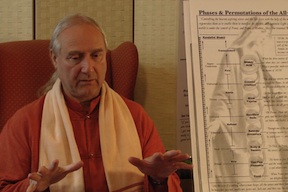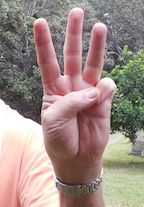Student Notebook
Winter/Spring 2014
Article Index
Class Notes January - April 15, 2014
Meditation
Formless meditation, maintaining one-pointedness for a long time (tailadhara dhyan), neither negates nor destroys God with form or the meaningfulness of Avatar's Lila; it simply brings those two eternal principles inward and gives them consummate meaning. Knowledge is now vast, infinite, and when one returns to form one has this infinite wealth to express for the highest good of others. How else could Sri Ramakrishna speak for a whole week on a single topic?
If one meditates on emptiness long enough, one will begin to see the Light. When going from bright daylight to a dark room, one's eyes need time to adjust. Likewise, when one comes from meditation on earth, air, fire, etc., to meditation on formlessness, it will take time to "see."
How do I practice death when it only happens once in a lifetime? By practicing meditation - at some point you will see your ego die previous to your body's demise. That is the practice called the death of death. Ego is your first presumption, so it is not really living. How can the nonliving die?
Dharma
Q: Hearing about God causes one to give up all worldly responsibilities. Should we do that?
Babaji: Yes, abandon your responsibilities in the world, but take them up in Brahman.
[While elucidating on the Four Parikarmas* combined with Sri Krishna's teaching that we are to be same-sighted with regard to friends, enemies, arbiters, etc., Babaji stated:] The Parikarmas help us keep our discrimination intact, and give us tools for interacting with various people. Though there is the same Atman in all people, encountering the evil must call forth the tool of indifference in us.
*Four Parikarmas: the Four Refinements or Beneficial Attitudes: Friendliness to the happy, compassion for the suffering, appreciation for the virtuous, and indifference to the evil.
People say they are living in the present. However, that is one of the phases of time that are connected to karma, in this case, prarabdha karma. By living in the present, one merely goes from experience to experience without extracting essential knowledge. So, you say you are living in your prarabdha karma? I can believe that. But where is the eternal moment? That has to do with inaction.
Through Holy Company the knots of the heart are cut, even without knowing that it is happening.
Through what kind of cleverness can one escape karma, especially horrendous karma? Cleverness will accomplish nothing, though it may work for a short time. You have heard of the "hound of heaven" that is always tracking the soul? Well "hell" has one too; its name is "Conscience." "Here Conscience, here Conscience!" One scarcely has to call it. It is on the trail of the karmi. Besides, there is the akashic record as well. It is like a compartment in the Cosmic Mind. All deeds are recorded there. One will have to look at them upon leaving the body.
[Discoursing on the chart "Lack of Spiritual Success and its Causes,” Babaji explained:]
Unless one lives in a dharmic family, the poisons never get acknowledged and dealt with. You want your bad karmas and samskaras to come up in holy company, not in family situations. Holy company will utilize the scalpel of wisdom. Taking refuge in pleasure and family — even in the body — provides no profound solution.
If the Self and Brahman are joined, then the world can join up. But if the Self and Brahman are not realized as one, then the world remains as Maya.
Nonviolence and action-in-inaction are two elevated dharmic teachings. Their implementation will remove all impediments in time.
When one starts with dharma, life leads naturally to Moksha, Freedom. Most people go after artha (wealth) and kama (desire) and find dharma along the way. When that happens, there is perhaps only a 50% chance that they will be led to Moksha. Why? Because there is the taint of money and it is difficult to adjust and see clearly – even to feel worthy to step into the Light of Brahman.
Dharma and Moksha are like the two pieces of bread in a sandwich. Artha and kama are covered by both.
Four Wet Paper Bags to punch out of:
1 - Ignorance, maya, fundamentalism, and the idea that objects are real and can satisfy you. You have to punch your way out of this before you can get at #2.
2 - Religious convention.
3 - Dharma teachings – not moral laws, but dharmic laws. Move beyond "thou shalt not kill," to "thou cannot kill." The dharma is going to find you, and you will recognize it because it is about your relationship with God.
4 - Sadhana – one has to start practicing what one hears. And this is the long way of saying "shruti." One has to hear these principles, and practice them.
Sadhana
Q: You recently said that "one might as well not seek ultimate enlightenment, because that is already you – but the intermediate steps you should go for, because they help awaken That which is already You."
Babaji: One cannot so easily see God without performing sadhana and awakening the consciousness within oneself. Then the intermediate realizations become available.
You have probably done various methods and found them wanting. That is why you will eventually come to the teachings of the Upanisads.
Body & brain constitute the gross body. Mind & intelligence make up the subtle body. These are two different bodies, but the second one is often left out of the equation, even in "wholistic" circles. The mind does not get its due as the subtle cause behind the effects we see. What does it matter that one eats well and exercises if all the while the mind is thinking unhealthy thoughts?
Seeking and striving are essential for Advaita Vedanta. Rigorous spiritual practices will remove one's doubts, and keep karmic dust from collecting on the mirror of the mind.
The Tantras tell us: "You are the darling of your own worship." If you can find your Self, you will find everything worthy within you."
Please secure and utilize spiritual discrimination, Viveka. You cannot love if you do not know what and what not to Love. Real love is Love of God. "Seek ye first the Kingdom of Heaven and all else will be added unto thee."
If one is seeking God with form, that is sweet dualism. If one is seeking the Father through the Son, that is salient qualified nondualism, and if one wants to merge in Oneness, that is serious Nonduality.
Five things to note in Pranayama:
1 - Perspiration – if one does not feel this, then one needs to intensify by degrees.
2 - Heat – the heat that is generated is indicative of opening the nadis, subtle nerve passageways.
3 - The heartbeat and its gradual decrease.
4 - Dizziness – this is the result of heart and mind getting connected before prana is stabilized. Your mind will feel like a flame in a windy place.
5 - Mind will feel like it is rising and thoughts will become calm.
Just do it. Just do your practice and then periods of clarification will come. And when you look back, you will see that ignorance evaporated when you were not looking.
We cannot solve problems at the same level they were created. Sri Ramakrishna cautions us not to study Maya from inside Maya. One cannot eradicate lust from inside lust, for instance, or anger from inside anger. One has to step aside, witness, then eradicate.
The things you renounce have been concealing the Self. So, when you renounce things, you get closer to your true Nature.
Dissolving the Mindstream
Maybe it seems scary to dissolve the mindstream, to dissolve into Consciousness. You think, "I will disappear." But you are the one who is doing the dissolving – how can you go away? Dissolving the mindstream is a powerful process the freedom-seeking soul does every morning. [in meditation]
People enter into individual form via the ego. Prior to that they are floating in the Cosmic Mind, perfectly happy. After that they are, as Ramprasad sings, "...consuming earth instead of nectar."
Do not be deceived, Nature is not all arrayed out here and then you come into it. No, you projected it. You are the formless Essence it all comes from.
We are shifting between form and formlessness all the time via the states of waking, dream, and deep sleep. Doing this unconsciously keeps us in ignorance of our nature as the unchanging Witness of all the phenomena that takes place there, including emptiness/formlessness.
Let us all have a 24/7 practice, that is, take practice into all three states of consciousness – waking, dream, and deep sleep.
One has to embody in order to dissolve karma; it cannot be done in heaven. Do you realize what actually happens with dissolving the mindstream? If one dissolves the body, lust is dissolved. If one dissolves thought, anger gets dissolved. Do not hold on to lust, anger, etc. – water the flowers, not the weeds.
One will not see the subtle tree unless one has one's subtle senses under control.
In the practice of dissolving the mindstream, one does not lose anything. You are just making connections. First see everything in you, then all of you in the Divine Being (Ishtam) you contemplate, and then dissolve everything in the Absolute Supreme Awareness.
[Discussing the chart, "The Adhara System of the Five Koshas," Babaji explained some of the subtle points of recognition, discernment, and connection with regard to contemplating the annamaya kosha (physical sheath), pranamaya kosha (sheath of vital energy), and the manamaya kosha (sheath of the mind).]: The illumined have connected the body-brain complex to the mind-intellect complex via prana. Prana causes one to love/hate, to think/not think, etc. Until one can control the senses (using prana) one cannot get off this ride of duality, and this leads us to the vijnana maya kosha [sheath of intelligence]. Thus, when using the Adhara System of the Five Koshas in the practice of dissolving the mindstream, one takes stock of the koshas by recognizing which kosha one is primarily identified with, what its limitations are, how it is supported by the next more subtle kosha, etc.
Connect the word to the mind, the mind to the intellect, the intellect to the ego, and the ego to the Witness, and the Witness to Brahman. This is the classic Vedantic method of dissolving the mindstream.
If a tree falls in the woods does it make a sound? This is the wrong question. The sound, tree, and forest are all unreal. By the time one has dissolved earth into water, and water into fire, and fire into air, and air into ether – one has dissolved the woods, tree, and its audible sound, and found the Essence of all three!
Know Your Philosophies
Eternal & Essential Facts of Nondual Indian Philosophy
1 - The Soul/Atman is different from and ever free of Nature.
2 - All of Nature has come out of the Soul, and as it does, no change takes place in the Soul.
3 - As Nature emerges from the Soul, it does so as mental projection rather than as actual creation.
4 - The Soul, Atman, has an eternal relationship with nature. If It identifies with Nature there is suffering, but if It only associates with Nature It sports freely.
5 - Nature has manifested and unmanifested sides, by which knowing, the Soul can remain free of cycles of birth and death in ignorance.
Vedanta, in its sweep, includes all systems and perspectives. They are Apaurasheya, Eternal. The rishis, or seers, are the first to see It, but they would not see It if It was not there already. Then they must decide on how to present It from age to age, culture to culture.
Vedanta siddhanta (conclusion) is that the world is unreal, an appearance. Science siddhanta is that objects are made of particles vibrating at a billionth of a second. We must make our own profound conclusion based on these that utilizes the proofs of emptiness and change to reveal what is ever-full and ever-stationary.
Waking, dreaming, deep sleep, periods of time, etc, – all exist in the eternal moment.
Each of the 40 - 50 spiritual paths in India are manasanas – firm postures of the Mind.
Everything is unproduced in its essence. When beings "produce" it with the mind, they court karma.
Creation, preservation, destruction are going on and on in cycles, like a tempest in a teacup, and everyone thinks they are real. No one believes in the Atman, the eternal Soul that holds that cup.
Triputis are the way out of the dualities, and there is a way beyond the triputis too; it is called The Fourth – the Supreme State.
A tamasic person goes into deep sleep and sees nothing; but Siva withdraws and sees everything. Siva goes inward, takes everything with Him, and examines all the particles of wisdom within.
"I am the body" is the first evolute of Maya. This is the first deception. Maya is the deceptive factor in the mind.
Form covers formlessness — external forms and internal forms — both cover formless essence.
Why are there so many souls? Just notice how many waves there are on the surface of the ocean. They are not really coming and going, are they, but rather rising and falling.
The Illumined Beings
Three Pillars of Sri Ramakrishna's Teachings:
1 - Divine Motherhood of God
2 - Universal Harmony of Religions
3 - Natural Renunciation
Spiritual life is all about Enlightenment, not entertainment.
Selflessness manifests as a person with no regard for his or her personal comfort. Divine Mother has gotten into that form for the benefit of all others.
The penultimate realization is "All this is unreal." The ultimate realization is that "All this is Brahman." In the latter, one sees God in everything. Sri Ramakrishna declares that this is the final word in spiritual life here in this body.
Prana Prana is the most addictive substance. Whatever you like, or are attracted to, it is the prana that gives it allurement.
Prana is the most addictive substance. Whatever you like, or are attracted to, it is the prana that gives it allurement.
People are told to watch their breath. Why? To calm the mind. But no one asks where breath comes from. If one jumps from meditation on gross objects straight to mind (by passing subtle senses and objects, and the fivefold prana), then one will never know prana's role in the process of manifesting objects and thoughts. This is a problem in the West today.
Most teachings around life force leave vital prana, psychic prana, and Shakti separate, but they are all connected. Unfortunately, it is the physical prana that gets most of the attention. Thus, inner life is left unseen and untapped.
One needs to connect the prana to the three matras of Om: inbreath is A, held breath is U, and outbreath is M. If these three are left unconnected, then life is left confused, and mind remains scattered.
Divine Mother is the subtlest Presence in and behind all things. Her Presence is there as the prana in food, in thinking-consciousness, and finally She is realized as Consciousness. This is a very refined understanding of what She is. Before this, one could not contemplate Her. One entirely missed Her presence. As the Svetashvatara Upanisad states:
Te dhyanayoganugata apashyan Devatmashaktim svagunairnigudham Yah karanani nikhilani tani Kalatmayuktanyadhitishtatyekah.
"Practicing the yoga of meditation, the seers beheld the Divine Being, Existing everywhere, and in everything, and which though veiled by its own modes of nature, was nonetheless one and indivisible – and which had been imperceptible earlier due to the limitations of their own intellects. Om peace, peace, peace."
Pithy Points to Ponder
The only reason to live is to live for others, otherwise one's god becomes the ego.
Until one knows the non-Self, one cannot truly know the Self.
One needs a teacher so one does not get off the path.
The key to freedom is selflessness.
Yogis have mastered these three: the need to eat, the need to sleep, the need to breathe.
If the people of this day and culture do not make a show of emotions each day, then they feel unfulfilled.
Brahman pervades everything, but fear invades everything. What we want in the interim is a gentle incursion of Knowledge that reveals everything.
God is not a creator; rather, mind is a projector.

Enlightenment is called waking up. One must stop dreaming.
A new peace sign: Babaji held up 3 fingers instead of 2 and said, "Peace, man" – Peace inside, outside, and on high.
The five senses cherish objects. Mind contributes the desire for them. Thoughts then dwell on them long after the experience should be over, and the intellect looks on in disbelief.
Three significant lifetimes:
1 - The lifetime where one wakes up, spiritually.
2 - The lifetime wherein one works out one's karmas
3 - The lifetime wherein one lives a free life, making it possible to give it all up.
The Three statements on growth, from the worldly person, to the seeker, to the Luminary:
1 - Why me?
2 - Who am I?
3 - I am Brahman.

